Day one |
Day two |
Day three
Feedbacks of Day one |
Feedbacks of Day two |
Feedbacks of Day three
Day Two
The conference was busy with visiting guests from the early morning.
 Morning Session
Morning Session
Opening Greetings
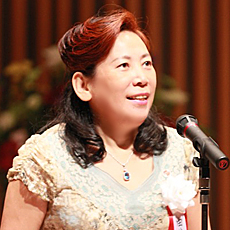
There was a greeting from JPHMA Chairperson Yui Torako.
The presentations from those living in the Great East Japan disaster area, and those from our overseas guests, touched my heart. I think these were very good presentations yesterday. We expect further great presentations today, on our second day. I want us to listen from a position of accepting one good idea from the studies of each of the lecturers today. It is part of our fundamental Japanese mentality to receive ideas, and to see if we can improve them.
As yesterday, a beachball of the Earth was thrown into the seating, and great shouts of joy broke out.
Conference Notice
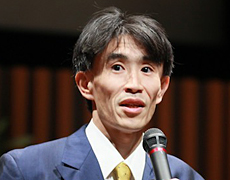
As with the previous day this was followed by the reading of legal notices by the JPHMA Lawyer Akiyama.
We were impressed us by the excellent presentations yesterday. These presentations are based on real experiences and truthes found in our daily lives and clinical practice, and we can share these experiences through our work here. We expect todays' presentations to be of an equally high standard.
Before the current presentations began,a brief pictoral digest of the previous day's events was played.
“Beyond Homeopathy: Applying Hahnnemann's Complete Medical System” by Rudi Verspoor
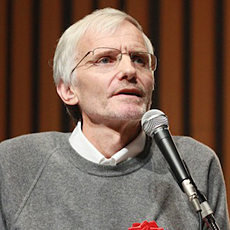
Rudy Verspoor has been studying the medical system of homeopathy for more than 20 years, with specific reference to Hahnemann's texts"Organon" "Chronic Disease" "Small essays".He has long-term clinical experience of complicated chronic disease.
I am very grateful to be here in wonderful Japan amongst such a large number of people. It was particularly important to support this conference after the cancellation of the ICH after the earthquake, tsunami and nuclear power plant incidents.I believe, as Hahnemann showed in his work,that homoeopathy will be a useful defence against the infections and radioactivity that are now present.
He explained about the mechanisms behind incidents of disease, noting the differences between the tonic and the pathic, and also the processes of initial and counter-action. He gave commentary on the original German in the texts of Hahnemann.
The presentation showed huge studies and extensive background to demonstrate how Hanhnemann classified, analysed and approached diseases that originated from more than one cause or state. Rudi provided explanations throughout. He left an important comment to the end of his presentation.
I think we have to read the original books to learn and fully understand something. To accept the opinions of others, or to read only translations, encourages misunderstandings and prejudice. We can only understand Hahnemann by reading "Organon" "Chronic Disease". Please read these thoroughly.
“The three dimentional method: Cases of developmental disorders and intractable diseases” by Torako Yui
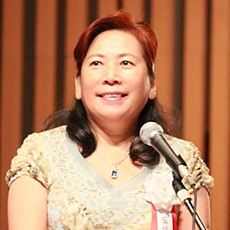
It was time for the presentation by Principal Ms. Yui on cases of developmental disorders and intractable disease.
Mothers who have children that are suffering from diseases, often blame themselves. They find it hard to be able to do so little to help their child. However when the mother stops blaming herself, and accepts her child unconditionally their relationship will improve; the mother will be happier and they will both feel the satisfaction of being loved. I have seen this process many times. I think it is really fantastic. You must be yourself.
Each case gave a clear understanding about real consultations using video, and describing the repertorizations from the TBR and the choices of remedies used in the three dimentional method, and finally, the process after prescribing. There was genuine surprise in the audience at just how visible the changes were for the patients as they underwent the curative process.
The presentation showed that the improvement rate was increased by the introduction of LM potency, and some common remedies were particularly effective for those clients.
“SAVE CHILDREN Homoeopathic self-care at home” by Teiko Sakamoto
Afterwards there was a presentation by Teiko Sakamoto, a representative student of the Family Homeopath course that started this year.
It was a story of discovering homeopathy and the experience of child care. Its humorous presentation evoked laughter in the hall, and the content made everyone realise how close the parents and children were, and their love and determination to protect the health of the family was applauded.
“Remarkable improvements in a child with developmental disorder” by Atuko Katagami
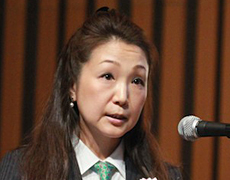
Her presentation described the case of a child withe developmental disorder who underwent remarkable improvements.
There were explanations about state of the child, timelines such as medical histories, and the chosen remedies for the client. It was a clear presentation of the processes of choosing a remedy, the prompness with which a patient can improve, and the current state of the patient was also explained in detail.
It was impressive that the client’s mother was so gratified by the improvement to her son's affliction.
"Case; 0 years old, atopic eczema all over the body" by Keiko Matuo
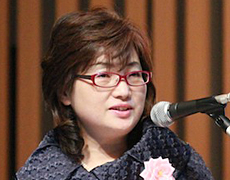
Her presentation describes the case of a recent newborn with atopic eczema which was improved.
The photograph of the patient’s face covered by eczema before the consultation and another photograph in which the eczema had gone after consultation were shown, and the improvement process was one of the best parts.
Poster presentations
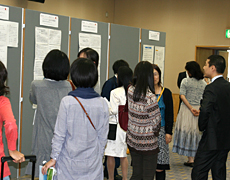
Poster presentations which summarized clinical results by the members of JPHMA from across Japan were displayed on the 2nd floor.
In the lunch break, many people surrounded exhibitions of various case studies and speakers. There were several people who asked the practitioners about their explanation and took notes intently, trying to get as much information as possible to take away with them.
 Afternoon Session
Afternoon Session
Japan-Hojyu-Natural agriculture volunteer Omikoshi, the portable shrine.
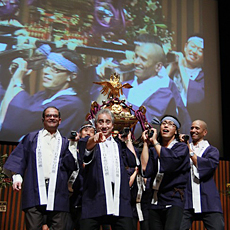
The Omikoshi by volunteers of The Japan-Hojyu-Natural agriculture was carried to the stage in the lunch break.
During the music of "the festival" by Saburo Kitajima, the Omikoshi was carried with cheers "wasshoi, wasshoi”.
The Kamanari Ceremony (Ancient Shinto ceremony)
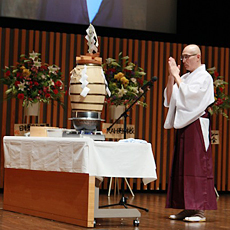
A big iron pot appeared on the stage after that, which was the Kamanari part of a traditional ceremony for Shinto and Shyukendo.
The ancient ceremony, which is believed to date back to the Burial Mound Era, is said to indicated one's luck for the forthcoming year by the loudness and length (or otherwise) of the hissing steam which escapes from under the lid of the pot when it is bought to the boil.The Kamanari held at the Kibitu shrine is one of the most famous.
This fascinating experience was new to many and was watched with solemnity.
“Mental health cases undergoing Wago medical treatment” by Yasunari Kageyama
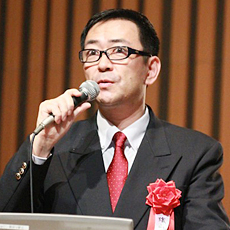
The presentation of Yasunari Kageyama, the chairperson of the Yugoukai Medical corporation and Director of the Takanawa Clinic, on "Wago medical treatment" a method that integrated Oriental medicine with Western medicine started the afternoon. Yasunari Kageyama is also both a licensed doctor and dentist.
He said western medicine is like monotheism, and that Oriental medicine is like polytheism. The Western medicine is subdivided into specialties such as internal medicine and surgery, while on the other hand Oriental medicine is a treatment which is diagnosed from the whole body. However, he thought that homoeopathy was polytheistic even though it was established in the West.
Several cases in which asthma, depression, and cancer were improved by a combination of dental and homeopathic treatments were shown. We realised that the corrosion of our teeth, and the presence of the metals to repair them influenced not just the oral cavity, but the whole body and could be responsible for new infections.
In both the Western and the other forms of medicine, the human will eventually die. Homoeopathic treatments happily focussed on a slightly different medical purpose which is to support the patients to live life to its fullest with in the best of their abilities.
“The Road to Similars” by George Dimitriadis
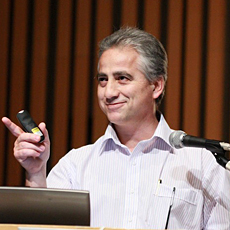
George Dimitriadis is a founder and Principal of the Hahnemann Institute in Sydney, Australia and well-known in the study of the Bonninghausen method. It was pointed out in this presentation that one of the most basic and yet most important principles in homeopathy was 'similia similibus curentur' (like cures like).
Many doctors and medical therapists had thought that "things of the same form and colour can cure the internal organs and symptoms that resemble the same form and colour" before homoeopathy was established. This isthe base principle of 'similia similibus curentur (like cures like)'. Hahnemann summed up these symptoms in a medical textbook entitled "Materia Medica". It is thought that the remedy which has many similar points with one's symptoms is the effective remedy. It is a mainstay of homoeopathic diagnosis to look for the remedy by this method. However can we say this is the most effective way?
There are many Materia Medicas handed down to posterity which have not been proven. Hahnemann himself sometimes likes to make jokes in the text,and this is a very important message from him to remember the origins of the process and not just to take the opinions of others on faith.
International forum
The forum entitled "Get back to Hahnemann" and "For the cooperation of homoeopaths beyond borders" was held by Chairperson Ms.Yui and guests.

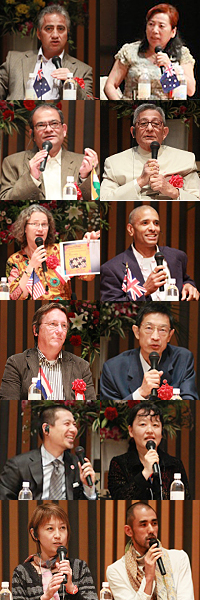
Chairperson Yui stated that she realized that the rate of healing amongst her clients has increased since she had adopted the principles advocated by Ewald Stoteler, Rudi Verspoor, and Dr. George Dimitriadis, who had studied the original texts to define their treatments.
The overseas guests praised the stance of chairperson Yui recognising that she took the best parts from the global network of homeopathy and improved upon it. They further complimented the high standards of Japanese homeopathy.
Throughout the world homoeopathy has now been recognised as a form of medical care; and in Japan it is likely that homoeopathy will become an important part of the medical sector so it is very important now to recognise how we must present our arguments and practices for the benefit of those in need.
Many of the guests were surprised by the passion of Chairperson Yui and the JPHMA members for homeopathy.
George Dimitriadis said "Above all passion is great, and it is important that we have passion".
As well as Chairperson Yui, the students of RAH and CHhom who spoke at the platform were of the opinion that it was important to have a position which reflected the best of the current approaches to the subject.
Chairperson Yui suggested that we establish a new support group to enable homoeopaths to co-operate globally. The meeting ended in the hope that all those with a common purpose would be able to contribute and assist each other.
The press conference
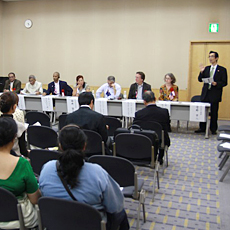
The joint press conference of the homeopathic international charity conference was held later in the day.
The reporters asked numerous questions such as“What is the specific reason why the Japanese homoeopathic standard is among the best in the world?” and “How will homoeopathy develop in the future?” These are the responses from Ms.Yui and her guests to these queries.
Chairperson Yui said, “There are 500 homoeopaths and 35,000 members of toranoko in the whole country. They have a strong desire to learn; it is at their request that we invite the first-class homoeopaths from the various countries in the world. I think that such an outlook on homoeopathy is rare in the world. If compare the history of Japanese homeopathy with that of other countries, it is a very short period - only sixteen years. We continue to learn so we can catch up. I suppose the reason why the JPHMA and CHhom succeeded are that we took on various methods without being seduced with any one method or dogma, and I have continued to teach from that position. I want the students to become great homoeopaths not a narrow-minded ones. For these reasons we can cooperate with homoeopaths throughout the world without difficulty in approach.”
Trevor Gunn said “Homeopathy has been taken up by various countries in of the world in several forms - while repeating the twists and turns. It is a strength that Japan can learn and turn those experiences of homoeopathy from overseas to their advantage. It is best way for Japan to adopt the good things we learned. The history of Japanese homeopathy is like the honeymoon of newly-married couple who are still deeply in love. I hope that they make use of the present passion and influence and that they will be able to expand more.”
Dr. Pratip Banerji from India - where are 70-80% of the nation use homoeopathy - explained the current status of homoeopathy in India where it was positioned as a primary medical treatment alongside western medicine and Ayurveda. He also described past problems and offered advice so that homoeopathy could expand in Japan as it had in India.
 Hahnemann Charity Party
Hahnemann Charity Party
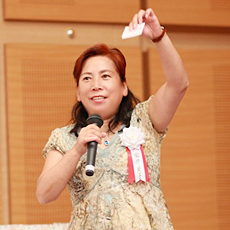
Second night Hahnemann Charity Party
At first we were warmed up by the 337 beats of ChairpersonYui, and then the party began.
After a volunteer group of CHhom students danced the Nankin Tamasudare, Chairperson Yui and the guests took a turn on the floor. They quickly improved and soon mastered it completely.
After the dancing came the main event - the charity lottery.
Many participans had bought charity tickets, and there were luxurious prizes which our overseas guests had donated . George Dimitriadis offered a volume of the "TBR" which had red cover and was part of a limited edition publication of ten. Those people who won the lottery were stirred because the prizes were not just valuable, but it seemed like the winners had also received the direct blessing the teachers too! Chairperson Yui additionally offered some of her power stone accessories. The people who got these wore them immediately for good luck.
※The full amount of donations made to this charity will put towards relief efforts through homoeopathy and reconstruction assistance in the affected area.
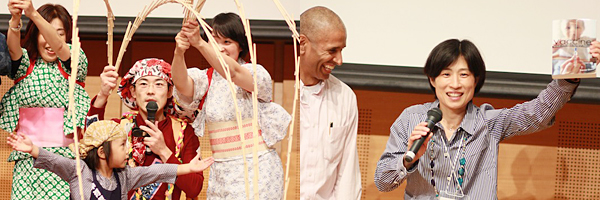
Day one |
Day two |
Day three
Feedbacks of Day one |
Feedbacks of Day two |
Feedbacks of Day three